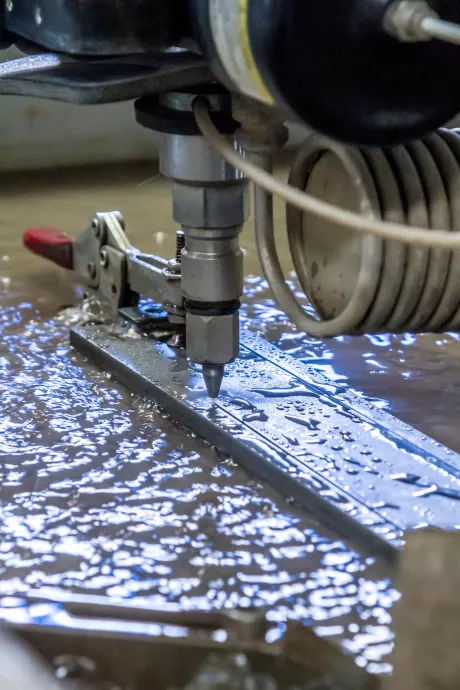Tips & Tricks
Waterjet Myths Uncovered - Pressure

Myth:
High Pressure Cuts Faster
Fact:
General statements like this are often misleading and rarely hold true across the board. The fact is that increasing pressure doesn’t lead to faster cutting in most applications.
Hydraulic horsepower is what does the cutting in abrasive waterjet applications, while pressure does the cutting in water-only applications. When you increase pressure, you must make a trade-off in your hydraulic horsepower to achieve the higher pressure.
How do you increase pressure?
There are two steps required to increase pressure from 60ksi to 90ksi in an abrasive application; the first is to increase your pump motor power and the second is to reduce your nozzle size to restrict your waterflow. With a higher motor in your pump, your waterjet system consumes more electrical amperage and more energy. The standard 90ksi pump uses a 480V 3-phase 200 AMP electrical connection whereas the standard 60ksi pump only uses a 100 AMP electrical connection to operate.
A larger motor can push more water through the cutting head, right? Yes, but that is only for operating the nozzle at a 60ksi pressure and we are trying to reach 90ksi.
The next step is to use the extra waterflow we just created with a larger pump and push it through a smaller orifice. This results in an increased amount of water attempting to get through the smaller opening, which forces it to go faster, or increasing the pressure of the water exiting the orifice. Increasing pressure means you end up with a smaller, thinner stream of water with reduced horsepower while consuming more electrical power.
Hydraulic Horsepower
Now, let’s remove the increased pressure and see what happens. You are no longer reducing the exit orifice size so all of that pressurized water is available to use right away, resulting in a larger, thicker stream to cut with. This translates to higher hydraulic horsepower at the cutting head with a stronger, more robust cutting stream.
For example, compare the water flow of a garden water hose to that of a fire hose. Which will cover more area faster? The smaller water stream or the larger water stream? Both will get the job done, but are intended for different environments and purposes.
In thinner or softer materials, it may make sense to use a higher cutting pressure, especially in water-only applications where abrasive and force aren’t necessary and a more focused stream with less horsepower would perform better. In thicker or denser materials where more force is desirable, horsepower will have the advantage and get the job done more efficiently.
A general statement may be true in some instances, but that does not mean it is ‘Always’ the case or even the most efficient or effective solution. Higher pressure will cut faster only some of the time. For most abrasive waterjet applications, higher horsepower at the nozzle proves to be the faster choice.




